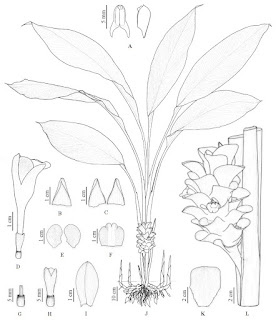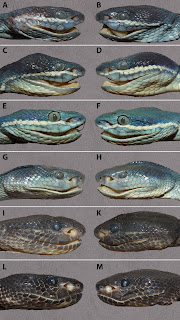[Most Recent Entries] [Calendar View]
Friday, October 20th, 2023
| Time | Event | ||||
| 6:03a | [Botany • 2023] Curcuma suraponii (Curcuma subg. Curcuma, Zingiberaceae) • A New Species from Tak Province, Northern Thailand
Abstract A new species, Curcuma suraponii Boonma sp. nov. has been collected in Tak Province, Northern Thailand during an exploration of Zingiberaceae diversity. This species belongs to the family Zingiberaceae and the genus Curcuma subgen. Curcuma. The plant materials were collected from their natural habitats and measurements were recorded from both living and preserved specimens. This species bears resemblance to Curcuma rubrobracteata Škorničk., Sabu & Prasanth, but differs in certain morphological characteristics and does not match any existing species. Therefore, the author described it as a new species to science under the name Curcuma suraponii Boonma. The description includes detailed information on its morphological characteristics, supported by illustrations, and provides the vernacular name, ecology, phenology, traditional utilization, conservation status, distribution map, and a comparative table to highlight its differences with allied species. Additionally, a revised key of 29 species within the Curcuma subgen. Curcuma in Thailand is also presented. Keywords: Curcuma, new species, taxonomy, Thailand, Zingiberaceae Thawatphong Boonma. 2023. Curcuma suraponii sp. nov. (Zingiberaceae), A New Species of Curcuma Subgen. Curcuma from Thailand. BIODIVERSITAS. 24(9); 4885-4895. | ||||
| 9:42a | [Diplopoda • 2023] Pseudoporatia kananciue • Additions to the Millipede Fauna of An Amazonian Ferruginous Landscape: A New Species of Pseudoporatia Golovatch, 1999 (Polydesmida: Pyrgodesmidae) widespread in Rock Outcrops
Here we describe the new species Pseudoporatia kananciue Iniesta, Bouzan, Souza & Brescovit, n. sp., widespread in the Amazonian ferruginous landscape of the state of Pará, Brazil. The species differs from its only congener P. perplexa Golovatch, 1999 by the presence of 19 body rings in adults (vs 20 body rings), the position of the porosteles on the paraterga, and the morphology of the gonopods. Notes on its ecology and comments on the diversity of millipedes in the region of Serra dos Carajás, state of Pará, Brazil, are also provided. KEYWORDS: Carajás, Brölemann, Schubart, cave-dwelling, subterranean fauna, new species Pseudoporatia kananciue Iniesta, Bouzan, Souza & Brescovit, n. sp. ETYMOLOGY. — The specific epithet “ kananciue ” (Kananciuê), a noun in apposition, refers to the main God of the indigenous tribe “Karajás”, original inhabitants of forests of the Araguaia River and the Serra dos Carajás, where the species is widely distributed. Luiz Felipe Moretti INIESTA, Rodrigo Salvador BOUZAN, Claudio A. R. SOUZA, Robson A. ZAMPAULO, Igor CIZAUSKAS and Antonio Domingos BRESCOVIT. 2023. Additions to the Millipede Fauna of An Amazonian Ferruginous Landscape: A New Species of Pseudoporatia Golovatch, 1999 widespread in Rock Outcrops (Diplopoda, Polydesmida, Pyrgodesmidae). ZOOSYSTEMA. 45(16); 463-498. twitter.com/Publi_MNHN/status/1704865873 | ||||
| 9:56a | [Herpetology • 2023] Trimeresurus uetzi • A New Green Pitviper of the Trimeresurus albolabris complex (Serpentes: Viperidae) from central and southern Myanmar
Abstract In the frame of our investigations on the systematics of the complex of species of Trimeresurus albolabris, we came across specimens from Myanmar variously referred to as Trimeresurus albolabris Gray, 1842 or T. septentrionalis Kramer, 1977 in the literature. We describe a new species of green pitviper of the genus Trimeresurus Lacépède, 1804 from central and southern Myanmar based on molecular analyses drawn from previously published phylogenies and new morphological data. This new species, Trimeresurus uetzi sp. nov., is broadly similar to both Trimeresurus albolabris and T. septentrionalis, but it differs from these latter species by a series of morphological characters such as presence of white pre- and postocular streaks in male, iris copper in male or green gold in female, more ventral plates, and a much shorter hemipenis. We compare this new species with Trimeresurus albolabris as currently defined and other species of this complex. We also emphasize the need for additional integrated studies on Trimeresurus albolabris sensu lato populations distributed in southern Indochina and Sundaland. Keywords: Reptilia, Crotalinae, new species, morphology, Indo-Burma region, Trimeresurus septentrionalis Gernot Vogel, Tan Van Nguyen, Patrick David. 2023. A New Green Pitviper of the Trimeresurus albolabris complex (Reptilia, Serpentes, Viperidae) from central and southern Myanmar. Zootaxa. 5357(4); 515-554. DOI: 10.11646/zootaxa.5357.4.3 | ||||
| 1:59p | [Botany • 2023] Acalypha bardotiana & A. inaequibracteata (Euphorbiaceae: Acalyphoideae) • Two New Species from northern Madagascar
Abstract Background and aims – Taxonomic knowledge of Acalypha in the Western Indian Ocean Region (WIOR; including Madagascar, Comoros, Mascarenes, Seychelles, and the Scattered Islands) has increased greatly in the last few years. This paper is the latest in a series of publications that have contributed to create a robust taxonomic framework for Acalypha in this region. Material and methods – The descriptions and illustrations of the new species are based on herbarium specimens and on some field images. Descriptions were made following standard procedures. Maps was prepared using QGIS software and preliminary conservation assessments was made following IUCN guidelines and criteria. Key results – Two species of Acalypha from northern Madagascar are described as new to science: Acalypha bardotiana sp. nov., found on the Montagne des Français (Diana region), and Acalypha inaequibracteata sp. nov., found in the Binara forest (Sava region). Line drawings, field images, distribution maps, and a discussion of their morphological and phylogenetic affinities, as well as the preliminary conservation assessments are provided. Keywords: biodiversity, conservation, IUCN Red Listing, protected areas, taxonomy, WIOR
Acalypha bardotiana I.Montero & Cardiel, sp. nov. Diagnosis: Acalypha bardotiana is morphologically close to A. lanceolata Willd. var. glandulosa (Müll.Arg.) Radcl.-Sm. but differs mainly by having a suffruticose habit and unisexual inflorescences (vs herbaceous habit and androgynous inflorescences), conspicuous stipules up to 8 mm long (vs inconspicuous stipules up to 2 mm long), petioles up to 8 mm long and leaf blades up to 9 cm long (vs petioles up to 4.6 mm long and leaf blades up to 6.5 cm long), and papillose-hispid capsules (vs smooth capsules). Etymology: The epithet honours Mrs Martine Bardot-Vaucoulon, a French botanist who has conducted extensive botanical research in Madagascar. She is also one of the collectors of the type specimens of this species and kindly provided us with some field images included in this paper. Acalypha inaequibracteata I.Montero & Cardiel, sp. nov. Diagnosis: Acalypha inaequibracteata is morphologically similar to A. ankaranensis I.Montero & Cardiel, but differs mainly by having minute stipules up to 2 mm long, with simple trichomes (vs. stipules up to 5 mm long, with simple and glandular trichomes), petioles 0.5−1(–1.5) cm long (vs petioles 3−5 cm long), ovate to elliptic-lanceolate leaf blades that are rounded to obtuse at the base and lack domatia (vs broadly ovate-lanceolate leaf blades that are subcordate to cordate at the base and have pocket-shaped domatia), and dimorphic female bracts (vs monomorphic female bracts). Etymology: The specific epithet refers to the presence of female bracts showing different shapes. Iris Montero-Muñoz, Geoffrey A. Levin, Concepción Vaquero Lorenzo, Laura González, José M. Cardiel. 2023. Novelties in the Genus Acalypha (Euphorbiaceae, Acalyphoideae): Two New Species from northern Madagascar. Plant Ecology and Evolution. 156(3): 365-373. DOI: 10.5091/plecevo.108024 | ||||
| 3:32p | [Herpetology • 2023] Oreophryne riyantoi • A New high elevation Species of Oreophryne Boettger (Anura: Microhylidae) from Sulawesi, Indonesia
Abstract We examined the morphology of 50 specimens of Sulawesian Oreophryne and recognize a distinct, undescribed species. Based on morphological data and supported with phylogenetic analysis of the 16S rRNA gene, it is herein described and named as Oreophryne riyantoi sp. nov. The new species is diagnosed by having a combination of rounded snout in dorsal and lateral view, indistinct tympanum, narrow interorbital distance, small hands, small terminal discs on fingers and toes, toes without webbing, short legs, and dorsal surfaces of head, body and limbs irregularly tuberculated in life. It was found in leaf litter on the forest floor in extremely wet primary montane forest on Mount Mekongga at an altitude of 2528 m asl. The forest-dwelling habit of this terrestrial frog is unusual because other terrestrial Oreophryne occuring at high-altitude live in open grassy or fern dominated meadows. Four endemic species of Oreophryne are now known from Sulawesi. However, herpetological research activities, including high elevation surveys and additional taxonomic work, are necessary to achieve a comprehensive understanding of Oreophryne diversity and phylogeography in Sulawesi. Keywords: Amphibia, endemic, frog, Mount Mekongga, morphology, phylogenetic. Oreophryne riyantoi sp. nov. Auni Ade Putri, Wahyu Trilaksono, Hellen Kurniati, Alan Thomas Hitch, Andrew Engilis, Jr., Kanthi Arum Widayati, Achmad Farajallah and Amir Hamidy. 2023. A New high elevation Species of Oreophryne Boettger (Anura: Microhylidae) from Sulawesi, Indonesia. Zootaxa. 5353(5); 455-467. DOI: 10.11646/zootaxa.5353.5.4 |
| << Previous Day |
2023/10/20 [Calendar] |
Next Day >> |




















